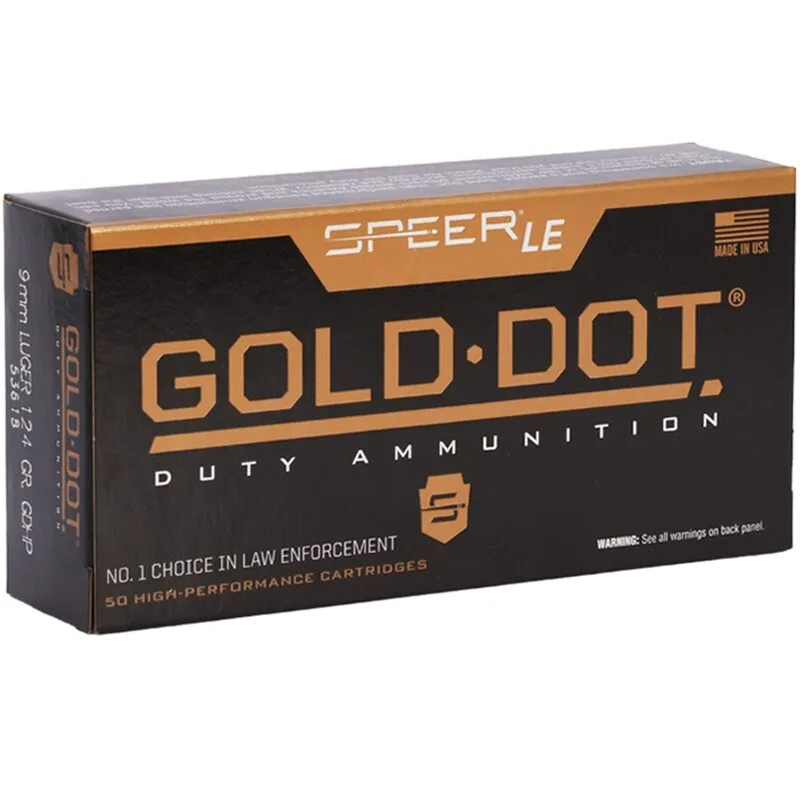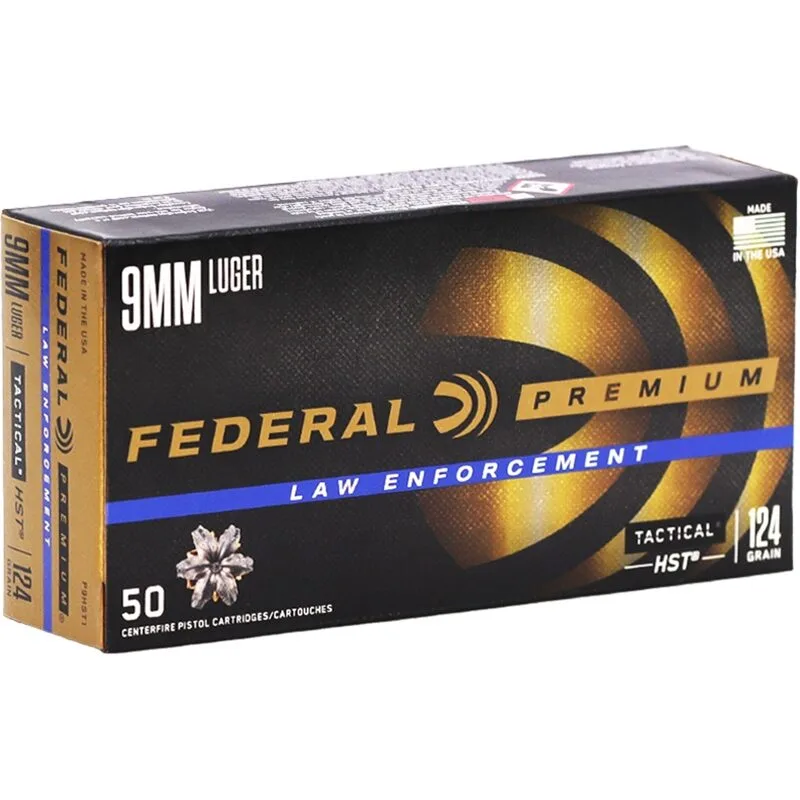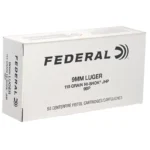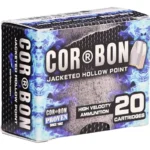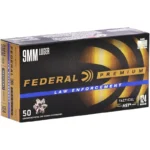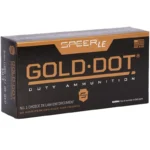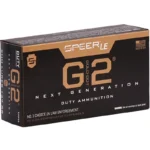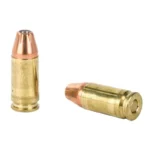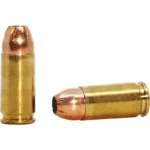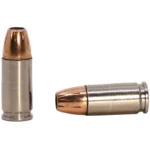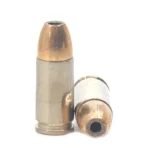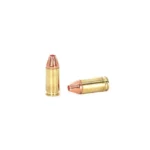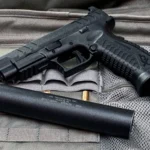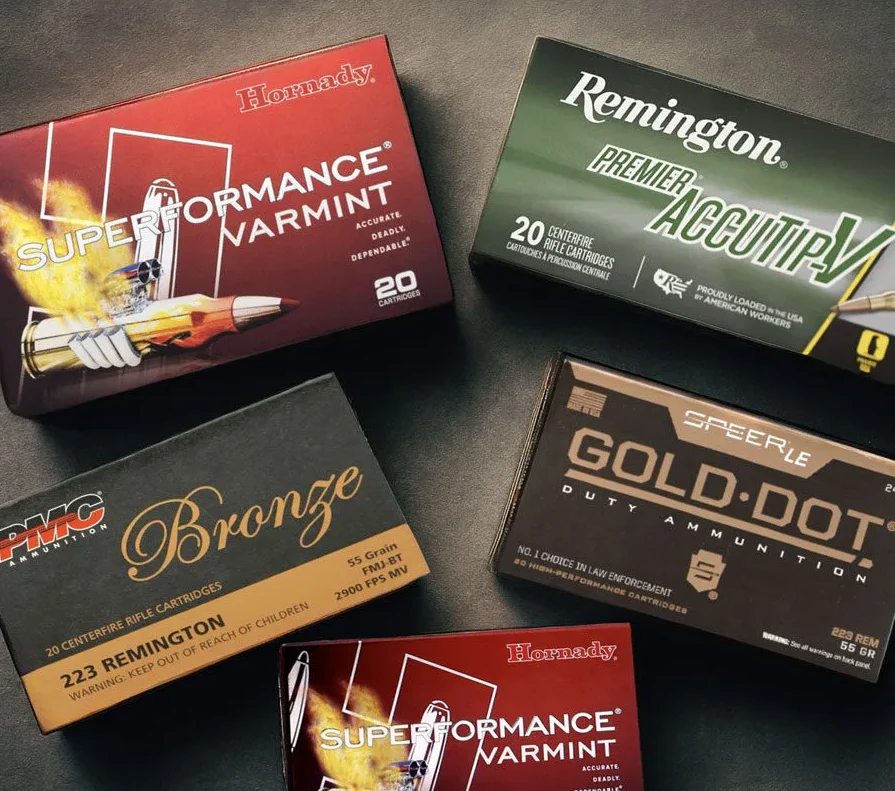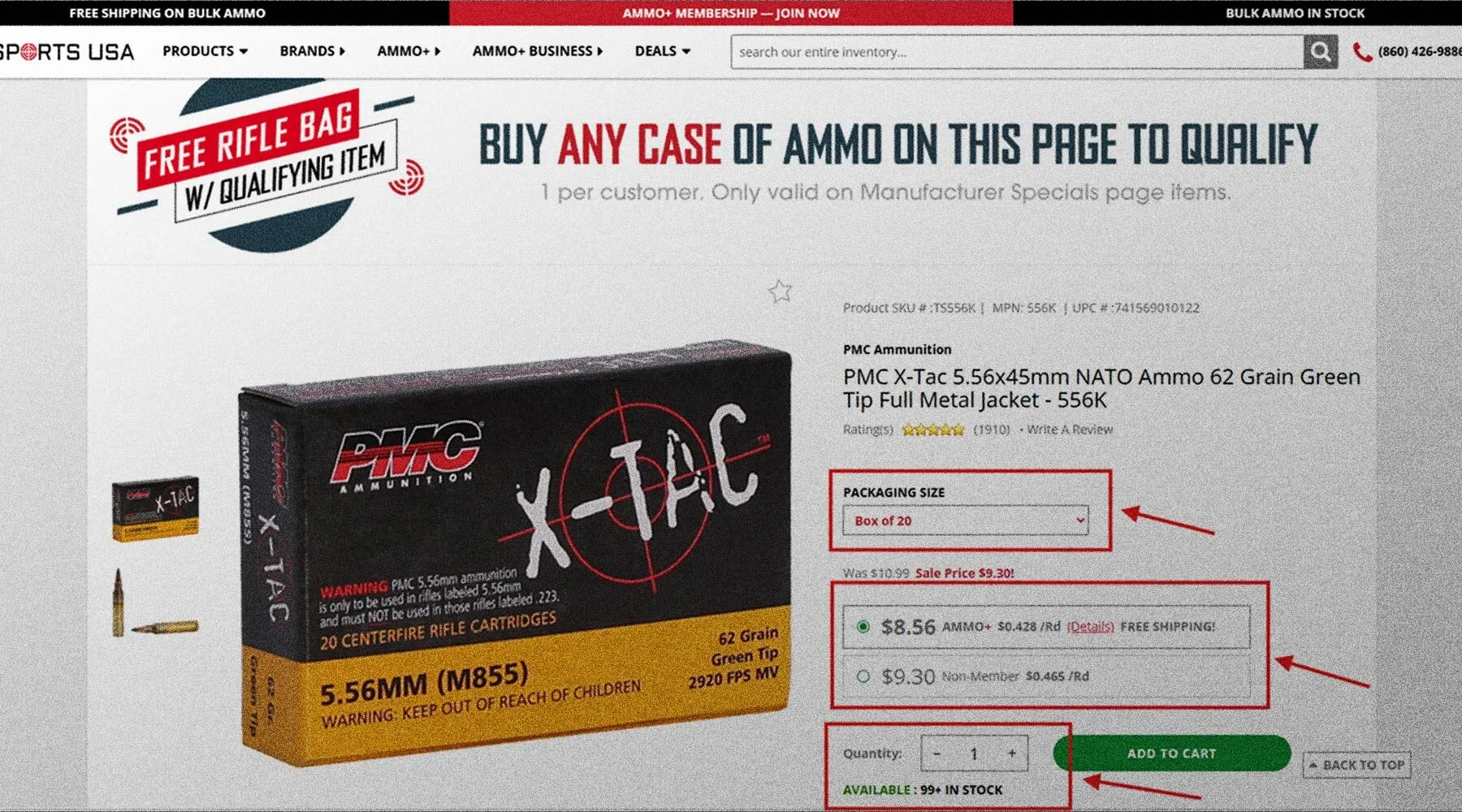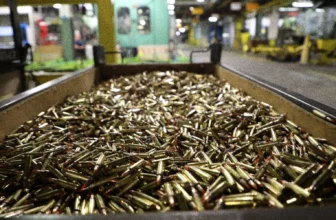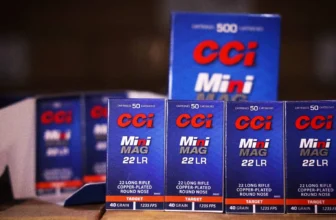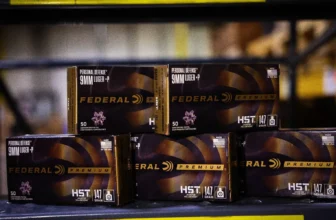When it comes to personal protection, few calibers have earned as much trust as the 9mm hollow point. It’s the go-to choice for concealed carriers, law enforcement, and everyday gun owners who value a balance of stopping power, manageable recoil, and magazine capacity. But not all 9mm ammo hollow points perform the same. Differences in bullet design, velocity, and expansion can make one round ideal for concealed carry while another is better suited for home defense.
TL;DR: Don’t feel like reading today? Here are some top picks for Jacketed Hollow Point loads.
Muzzle Energy 327 ft lbs
Muzzle Energy 365 ft lbs
Muzzle Energy 466 ft lbs
Quick Take, No Fluff: 9mm hollow point ammo expands on impact to stop threats fast and reduce overpenetration, that’s why it’s the standard for self-defense. Stick with proven JHP loads like Federal HST, Speer Gold Dot, or Hornady Critical Duty in 124 grain. Test them in your gun, confirm reliability, and check your local laws before carrying.
Notice: Prices shown are accurate at the time of writing and may change without notice. | Skip To Our Ammo List
In this guide, we’ll break down exactly what makes hollow point ammo effective, how it compares to FMJ rounds, and which brands and loads deliver reliable real-world performance. Whether you’re choosing your first box of 9mm self defense ammo or upgrading to premium +P loads, this guide will help you make an informed choice for your firearm and situation.
Quick guide: What are 9mm hollow points and why they matter for self-defense
What “hollow point” means in plain terms
A hollow point is a bullet with a cavity in its nose. That cavity encourages the bullet to expand on impact instead of passing through cleanly. For self-defense, that expansion helps the bullet transfer more energy to the target, create a larger wound channel, and reduce the chance of overpenetration compared with a full metal jacket round.
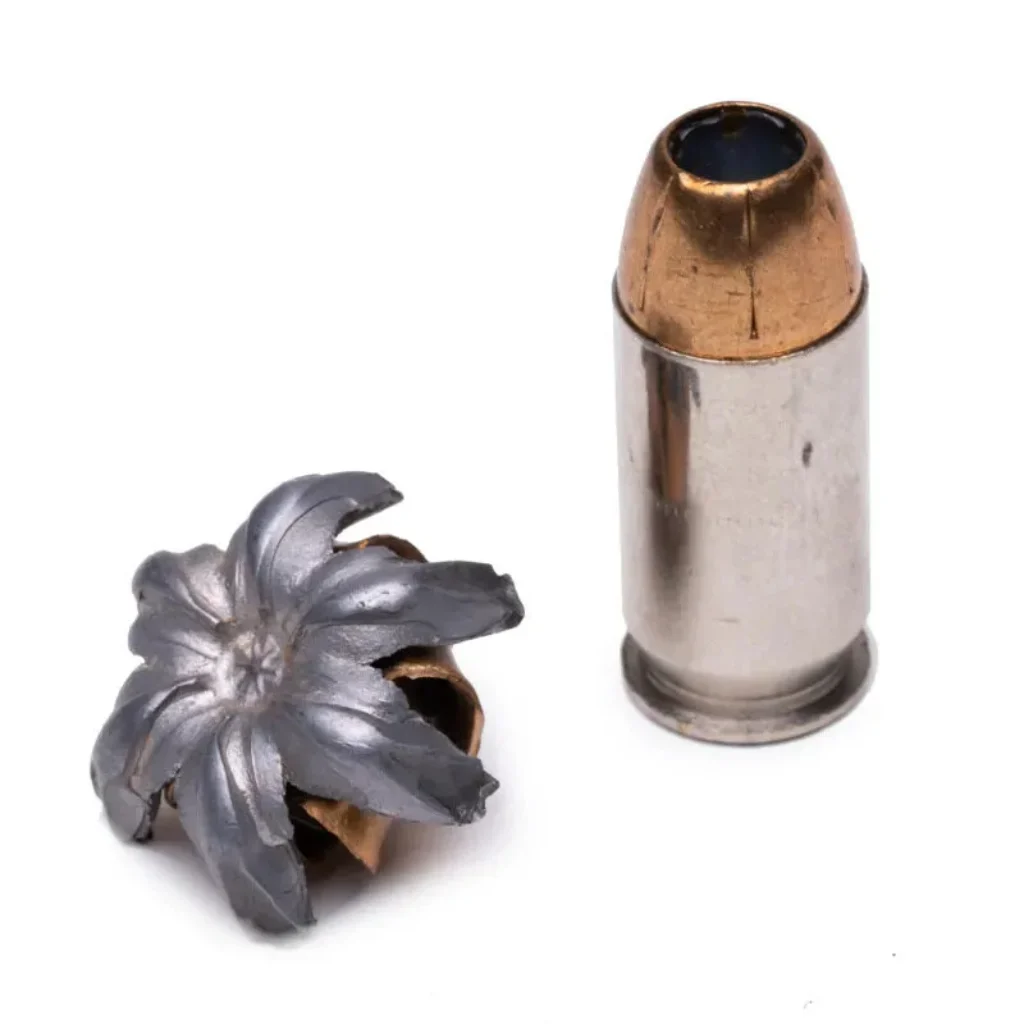
How hollow points behave on impact vs Full Metal Jacket
Compared to FMJ (full metal jacket), 9mm hollow point ammo is designed to slow and dump energy inside a target. FMJ is more likely to punch through barriers and keep going “Ouch…”. Hollow points, when they expand as intended, tend to stop sooner and cause more immediate tissue disruption. That makes them the preferred choice for most defensive shooters who care about stopping a threat while minimizing risk to bystanders.
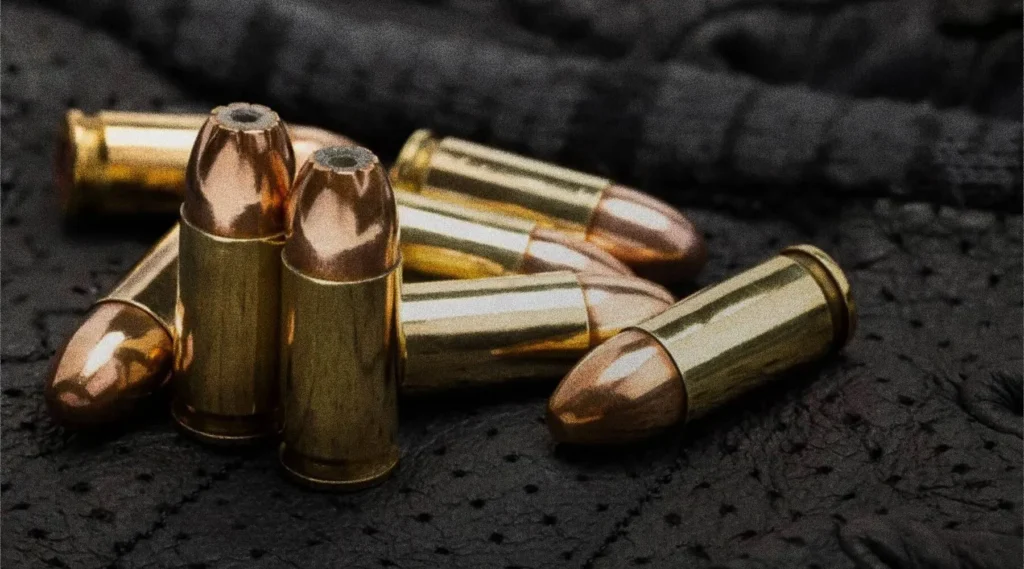
And if you’re curious about why the tip of a hollow point looks the way it does after impact compared to the full metal jacket, here’s the short version:
It’s called mushrooming. This happens when the hollow cavity and jacketed design force the bullet’s tip to peel outward and flatten, forming a mushroom-like bell. “Amazing, right?”. That wider profile increases frontal area, dumps more energy into the target, and reduces the chance of overpenetration, which is why reliable mushrooming is a key goal for defensive hollow-point designs.
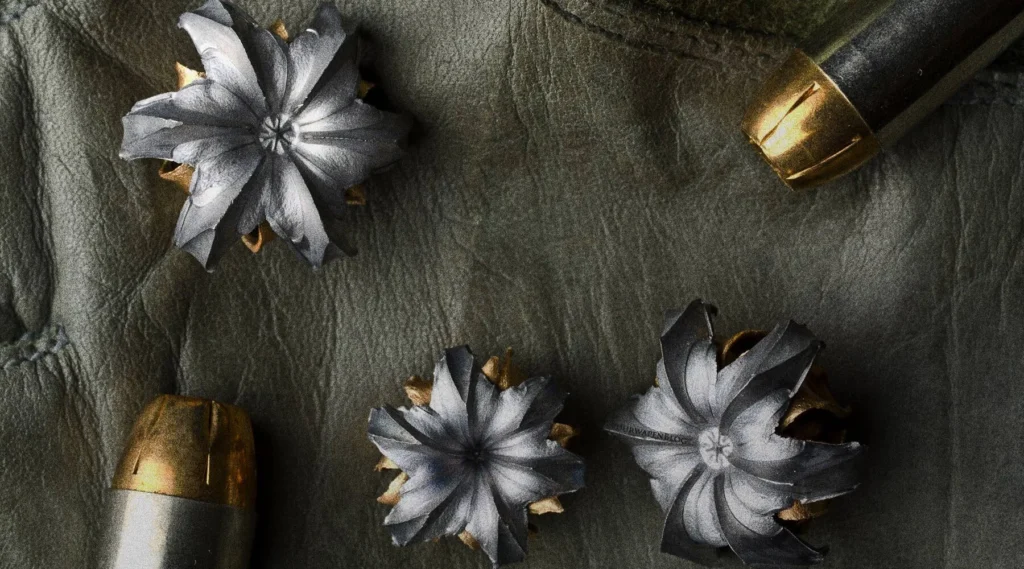
Hey, if you’re into home defense tips, we recently dropped a new blog post talking about “The Best Home Defense Ammo That Won’t Go Through Wall.” We’ve included the best rounds to use also… definitely worth checking out!
When to pick hollow points (short checklist)
- Concealed carry: priority on stopping power and reduced overpenetration.
- Home defense: choose rounds that expand well but penetrate enough to reach vital organs.
- Training: practice with similar-weight rounds to match real-world recoil and point of impact.
How hollow points stop threats — terminal performance explained

Expansion, energy transfer, and wound channels
Hollow point bullets are engineered to deform on impact. That deformation increases frontal area, which slows the bullet more quickly and transfers kinetic energy into the target. The result is a larger wound channel and more immediate physiological trauma than an equivalent FMJ round. In simple terms: more energy dumped where it counts means a higher chance of stopping a threat fast. When evaluating 9mm hollow point ammo, look for consistent expansion at typical defensive velocities, that is the real advantage over plain-jane projectiles.
Penetration vs overpenetration: balancing safety and effectiveness
One of the core trade-offs for defensive ammo is penetration depth. You need enough penetration to reach vital organs through clothing and possible intermediate barriers, but not so much that the bullet exits and endangers bystanders. Quality 9mm hollow point loads are tuned to expand reliably while still meeting the commonly referenced penetration window for self-defense (enough to reach deep tissues, but usually not full exit). That balance is why many shooters prefer 9mm self defense ammo over FMJ for everyday carry and home defense.
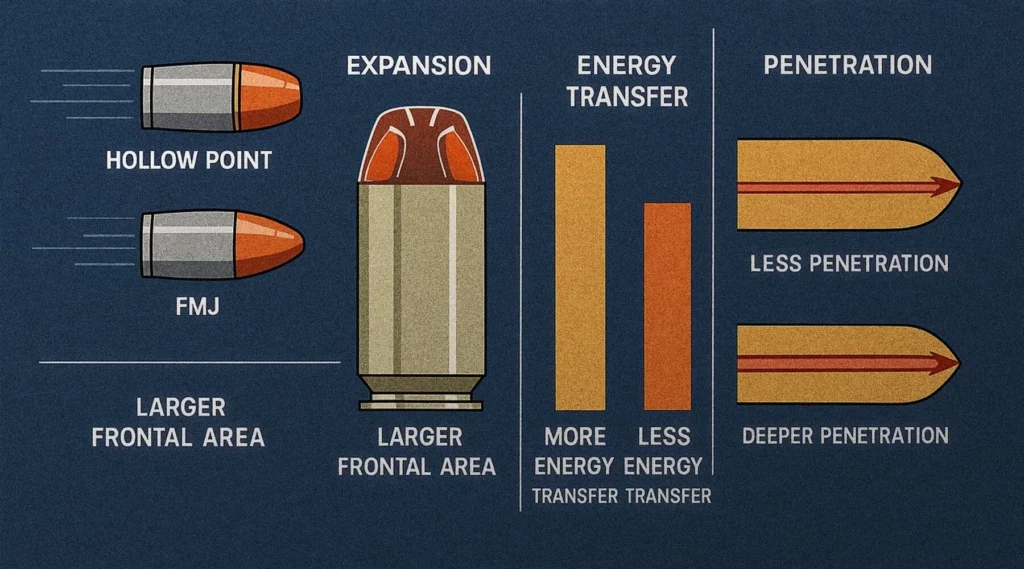
Real world performance vs ballistics gelatin
Ballistics gelatin tests give useful, repeatable data on expansion and penetration, but they are not perfect stand-ins for human anatomy. Gelatin helps you compare loads side by side, expansion diameter, retained weight, and penetration depth, but real incidents include variables like clothing, bone, angle of entry, and multiple shots. Treat gelatin as a performance baseline. When we talk about the “best 9mm self defense ammo,” prioritize rounds with consistent, controlled expansion in independent gelatin testing and documented field use.
What affects terminal performance in your gun
- Bullet design: JHP profile, bonding, and cavity geometry strongly influence how a round expands.
- Bullet weight: common 9mm grains (115, 124, 147) affect momentum and expansion behavior.
- Velocity: barrel length and +P loads raise velocity, which can improve expansion but may increase recoil and wear.
- Barriers: heavy clothing, glass, and drywall can alter expansion; some designs handle barriers better than others.
Choose ammo that runs consistently in your specific firearm and at the speeds your barrel actually produces. It’s worth matching your practice ammo to your defensive load whenever possible, or at least running a few boxes of your carry rounds to confirm they feed smoothly and hit where you aim.
Effective range and typical ballistics for 9mm hollow points
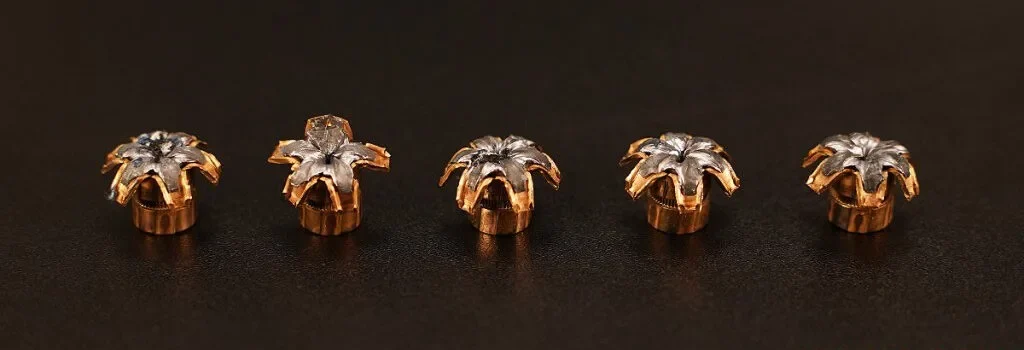
Typical velocities and how grain affects behavior
Bullet weight matters. Common 9mm hollow point grains are 115, 124, and 147 each behaves differently:
| Bullet Weight | Typical Muzzle Velocity ≈ | Typical Muzzle Energy ≈ |
|---|---|---|
| 115 gr JHP | ~1,150 ft/s (≈ 350 m/s) | ~340 ft-lbs (≈ 460 J) |
| 124 gr JHP | ~1,140–1,160 ft/s (≈ 345-355 m/s) | ~350–360 ft-lbs |
| 147 gr JHP | ~990–1,000 ft/s (≈ 300-305 m/s) | ~320 ft-lbs |
These values vary a lot by manufacturer, load specification (+P or standard pressure), barrel length, and test medium (ballistic gel vs actual tissue) — treat them as broad averages, not fixed.
- 115-grain JHP — lighter, higher velocity, flatter trajectory. Often chosen for target and some carry loads when shooters want a snappier recoil and slightly higher muzzle velocity. Good for point-and-shoot situations inside typical defensive distances.
- 124-grain JHP — the most common compromise: reasonable velocity, reliable expansion, and controllable recoil. Many duty and carry loads use 124gr because it balances momentum and expansion.
- 147-grain JHP — heavier, slower, often subsonic or near-subsonic from short barrels. Tends to offer deeper momentum and can perform better through barriers; commonly favored for suppressed builds or shooters who prefer softer recoil.
When shopping for the best 9mm self defense ammo, match grain to your pistol, recoil tolerance, and whether you need barrier performance.
115-grain Hollow point examples
124-grain Hollow point examples (very common defensive/LE loads)
147-grain Hollow point examples (heavier subsonic/defensive loads)
Notes: velocities/energies above are manufacturer-published SAAMI/test-barrel values (usually a 4.00″ test barrel) or official product specs from the maker or product spec sheet. Real-world chronograph/gel results vary by firearm, barrel length, and load lot.
Practical effective range for defensive use
For self-defense and home defense, the effective engagement range for 9mm hollow points is short: most defensive shootings occur inside 25 yards, and many inside 7–15 yards. Within these distances, modern 9mm JHPs produce controlled expansion and reliable terminal performance. You can absolutely hit targets past 25–50 yards, but for defensive planning, optimize for close quarters: accurate shot placement, reliable feeding, and consistent expansion matter more than long-range trajectory.
How barrel length and +P loads change performance
- Barrel length: Longer barrels generally produce higher muzzle velocity and can improve expansion and energy transfer. Short (subcompact) pistols will usually push a load slower than a 4″ or 5″ service barrel, which can affect how a particular JHP expands. Always test your chosen defensive loadout on your actual gun.
- +P and +P+ loads: +P (and the rarer +P+) increase chamber pressure to raise velocity. That often improves expansion for some bullets, especially heavier JHPs fired from short barrels, but brings increased recoil and additional wear on the gun. Not all pistols are rated for +P/+P+ — check your firearm manual.
Quick practical takeaway
Choose a load you can shoot accurately and reliably from your carry gun, preferably one with independent gelatin or barrier test data that shows consistent expansion for your barrel length. For most people the 124-grain JHP is a safe default; pick 115 or 147 based on recoil preference, barrier concerns, or suppressed use.
What Are the Different Types of 9mm Hollow Point Ammo?
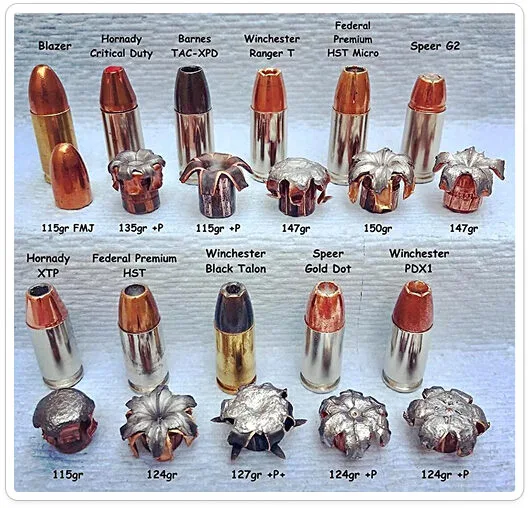
Jacketed Hollow Point (JHP) — the baseline
JHP is the archetypal 9mm hollow point. It has a metal jacket with a cavity at the nose that promotes controlled expansion. Jacketed Hollow Points are the backbone of most 9mm JHP ammo lines because they reliably deform, retain enough weight, and feed well in a wide range of pistols. Expect predictable expansion in gelatin tests and consistent real-world performance when paired with a well-designed bullet profile.
Bonded hollow points — retention and deep penetration
Bonded hollow points chemically or mechanically bond the jacket to the lead core. That reduces jacket separation on impact, so you retain more bullet weight and get deeper, more consistent penetration through heavy clothing and intermediate barriers. These loads are often recommended as 9mm self defense ammo when you want both expansion and reliable weight retention.
Controlled expansion / jacket-ported designs
Some JHPs add features like scored jackets, pre-formed petals, or jacket ports to control how a bullet peels back on impact. The goal is predictable expansion diameter and penetration depth across a range of velocities. Those design tweaks reduce variability between shots and between different barrel lengths.
+P and +P+ hollow points — higher velocity options
+P loads increase chamber pressure to raise muzzle velocity. For certain hollow point designs, especially heavier grains fired from short barrels, +P improves expansion reliability. +P+ goes further and is uncommon for commercial civilian loads. Important note: not all pistols are rated for +P or +P+. If you consider 9mm +p ammo or 9mm +p+ ammo, verify your firearm manufacturer supports it and understand it increases recoil and wear.
Polymer-tipped and hybrid designs
Polymer tips can be fitted to hollow point-style bullets to improve aerodynamics and ensure the tip drives into the cavity to initiate expansion. Hybrid designs blend features of FMJ, JHP, and bonded cores to balance feeding reliability with terminal performance. These are often marketed as premium 9mm defense ammo.
Fragmenting and defensive frangible designs
Fragmenting hollow points are engineered to break apart on impact, creating multiple wound paths and maximum energy transfer in soft tissue. They generally reduce overpenetration but can be less predictable through barriers and are not suitable where fragments risk unintended harm. Frangibles are niche in defensive use but common in some duty and specialized roles.
Specialty barrier-blind designs
Some hollow points are specifically engineered to expand through clothing, glass, or auto sheet metal while resisting clogging. These barrier-tested loads are useful for duty or scenarios where intermediate barriers are likely. Look for independent barrier testing data when evaluating these rounds.
Quick comparison: hollow-point & defensive ammo types
| Type | Typical use/notes | Typical use / notes |
|---|---|---|
| JHP (Jacketed Hollow Point) | Reliable expansion; good all-around performance | General self-defense and duty use |
| Bonded JHP | Better weight retention; deeper penetration | Barrier performance and hunting; holds together on impact |
| Controlled-expansion JHP | Predictable, consistent expansion across conditions | Defensive loads where repeatable performance matters |
| Fragmenting / Frangible | High immediate energy transfer; reduced risk of over-penetration | Close-quarters, training on steel targets, or specific tactical uses |
| Polymer-tipped / Hybrid | Improves feeding; promotes consistent expansion | Combines ballistic efficiency with hollow-point expansion |
| +P / +P+ | Higher velocity and expansion potential; more recoil and wear | Use only in firearms rated for +P/+P+; designed for enhanced stopping power |
| Barrier-tested (Barrier-blind) | Specifically tested to expand through intermediate obstacles | Recommended when barrier performance (clothing, glass, etc.) is a concern |
Hollow Point Round Up
9mm hollow point ammo gives you the best mix of stopping power, reduced overpenetration risk, and shootability for most civilian self-defense needs. Pick a proven JHP or bonded load that functions in your exact pistol, favor 124 grain as the reliable default, and consider +P only if your gun is rated and you’ve tested it. Test for feeding, point of impact, and consistent expansion, train with similar-recoil practice rounds, and always check local laws before carrying or transporting hollow points.
Thanks for checking out our blog on 9mm hollow points! Everything beyond this point includes extra overviews and deeper info if you want to dig in further.
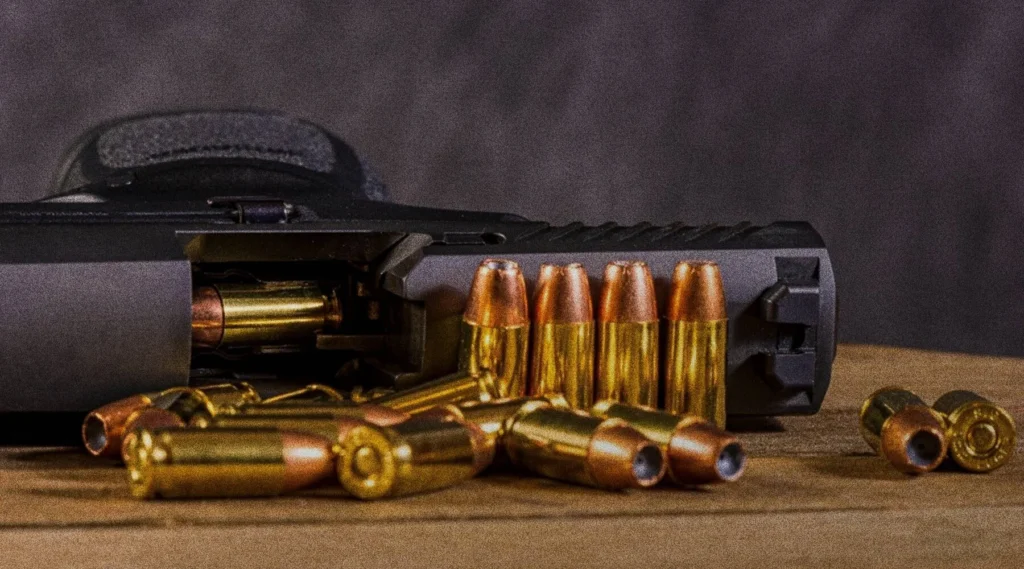
Best 9mm hollow point ammo for self-defense — brand and load overview
Below are proven, widely recommended 9mm hollow point loads you should consider. Each entry lists grain, typical muzzle velocity as published, and the best use case so you can match a load to your carry or home defense needs.
- Federal Premium HST, 124 grain JHP — ~1150 fps out of a 4.0″ test barrel. Trusted by many agencies for consistent expansion and weight retention, it is a top pick for everyday carry and duty use.
Best for: Reliable all-around carry load with strong independent gelatin results. - Speer Gold Dot, 124 grain JHP (+P options available) — ~1150–1220 fps depending on load and package. Gold Dot uses a bonded core that resists jacket separation through barriers, which is why it is a go-to for law enforcement and concealed carriers.
Best for: Barrier performance and consistent expansion, especially if you may encounter heavy clothing or glass. - Hornady Critical Duty / Critical Defense (FlexLock), 124 grain — Critical Duty is offered as a +P barrier-blind FlexLock design (~1175 fps in published specs) while Critical Defense focuses on reliable expansion in shorter barrels. Hornady’s duty-grade line is built to meet tougher barrier tests.
Best for: Duty-style loads or carry when barrier performance is a priority. - Winchester Defender / PDX1 Bonded, 124 grain +P — ~1200 fps in published product info. Bonded construction improves weight retention and deep penetration. Winchester markets these as solid defensive loads for both carry and home defense.
Best for: Deep-penetration scenarios and shooters who prefer bonded bullets. - Remington Golden Saber (Bonded options), 124 grain — ~1125 fps for standard Golden Saber; bonded Golden Saber +P variants are available with higher performance specs. The Golden Saber family emphasizes expansion plus high weight retention.
Best for: Barrier resistance and weight retention when deeper penetration is desired. - SIG Sauer Elite V-Crown, 124 grain JHP — ~1165 fps published for the Elite V-Crown. V-Crown is designed for controlled expansion and dependable feeding, positioning it as a strong concealed carry option.
Best for: Balanced carry load with smooth feeding and predictable expansion.
Quick notes on picking between these loads:
- Most shooters are well served by a 124 grain JHP in standard-pressure or +P form. It balances expansion, penetration, and recoil. Use the specific product pages and independent test data to confirm performance in your barrel length.
- +P can help with expansion from very short barrels, but increases recoil and wear on your firearm. Confirm your pistol is rated for +P before buying.
- Budget vs premium: Premium bonded or bond-enhanced JHPs cost more but perform better through barriers and retain weight. If you carry, spending a bit more on proven defensive ammo is common advice among trainers and LE.
How to choose and verify:
- Pick 2–3 candidate loads from the list above.
- Test them in your pistol for feeding, point of impact, and felt recoil.
- Review independent gelatin and barrier testing where available. Prioritize consistent expansion and penetration suited to home or carry scenarios.
Concealed carry vs home defense — different priorities
For concealed carry you want a load that’s reliable, controllable, and compact-friendly. That means manageable recoil, reliable feeding from your specific pistol, and a bullet that expands well without gross overpenetration. For home defense you can afford slightly heavier recoil and prioritize penetration through clothing or barriers inside a house (walls, furniture). At home you might carry a 124–147 grain load in a full-size service pistol; for concealed carry a 115–124 grain JHP is common.
What grain 9mm is best for home defense?
- 124 grain is the best all-around choice for most home defense scenarios — it balances penetration and expansion.
- 147 grain can give more momentum and deeper penetration (useful if barriers are likely), but it’s slower and may have a different point of impact in your gun.
- 115 grain is lighter and faster with snappier recoil; okay for close-range carry but may offer less momentum through heavy barriers.
+P and short-barrel considerations
If you carry a subcompact with a very short barrel, +P loads often help ensure reliable expansion. However, +P increases felt recoil and accelerates wear; only use +P if your pistol is rated for it and you’ve tested it for feeding and POI (point of impact).
Practical load-selection checklist
- Match load to your gun: test each defensive load in your exact firearm for feeding, function, and point of impact.
- Prioritize reliability: if a round causes malfunctions, it’s not a defensive round for you.
- Balance expansion and penetration: pick a round with independent gelatin or barrier test data that fits your use case.
- Train with similar recoil: practice with either the defensive load or a ballistically-similar training round so you know your real-world performance.
- Consider magazine capacity and carry ergonomics: lighter recoil often means faster follow-up shots and better control in close encounters.
Home-defense setup tips
- Use a full-size pistol or shotgun if you’re comfortable with it at home — better sights, longer sight radius, and higher velocity from a longer barrel aid terminal performance.
- If worried about overpenetration in a house with occupants nearby, choose tested hollow points with reliable expansion but moderate penetration, and favor shot placement training.
- Keep a spare magazine, flashlight, and a practiced plan for moving through your home; ammo choice matters, but training and tactics matter more.
COST AND AVAILABILITY
Hollow point defensive ammo generally costs more than bulk FMJ target rounds. Premium JHPs, bonded bullets, and barrier-tested loads carry a price premium because of more complex manufacturing and testing. That means many shooters buy FMJ for range practice and reserve JHP for carry. Factor cost into your training budget so you still practice with similar recoil and point of impact. Shop the JHP ammo we write about at Target Sports USA, with free shipping on bulk/case purchases.
Feeding and reliability concerns
Most modern JHPs feed and function reliably in contemporary pistols. However some hollow point profiles can be picky in older or unusual designs. Always test any defensive 9mm hollow point ammo in your firearm for feeding, ejection, and point of impact before carrying it. If a round causes stove pipes or failures to feed, it is not a defensive option for you.
Wear on firearms and +P considerations
+P and especially +P+ loads raise chamber pressure and increase muzzle velocity, which can improve expansion in some loads but also increase recoil and accelerate wear on springs, extractors, and barrels. Only use +P if your pistol manufacturer rates the firearm for it. Using +P in an unrated gun can shorten service life and may affect safety.
Overpenetration and bystander risk
Although hollow points reduce the likelihood of overpenetration compared with FMJ, no expanding bullet is guaranteed to stop inside the target every time. Shot placement, bullet construction, and barriers all change outcomes. You must accept a residual risk that bullets can still exit and endanger others. For environments where bystander risk is high, choose loads with documented controlled expansion and moderate penetration, and focus on avoidance and deescalation where possible.
Legal and travel restrictions
Hollow points are legal for civilian defensive use in most places, but there are notable exceptions and restrictions in some jurisdictions. Laws also vary for transporting ammunition across borders and on aircraft. Always check local and state law before purchasing or carrying hollow point ammo. Treat this article as informational and not legal advice.
Environmental and storage issues
Lead-based bullets pose environmental hazards if used at outdoor ranges without proper containment. Also store defensive ammo in a cool, dry place to avoid corrosion and preserve performance. Rotate carry ammunition periodically to avoid long-term degradation of primers and propellant.
Perception and social considerations
In some contexts carrying hollow points may trigger extra legal or investigative scrutiny after a defensive shooting. Law enforcement and courts focus on necessity, proportionality, and legal compliance more than the presence of hollow points alone, but be aware of how your choices may be perceived.
Quick mitigation checklist
- Test any defensive JHP in your gun for reliability and POI.
- Use +P only if the firearm is rated for it and you accept increased recoil and wear.
- Practice regularly with similar recoil profiles.
- Check local laws regarding hollow points and transport.
- Consider bonding or barrier-tested JHPs if you expect intermediate obstacles.
Legal restrictions and carry legality
Short answer: 9mm hollow point ammo is legal for civilian use in most places, but laws vary widely by country, state, and even local jurisdiction — so always check the rules where you live and travel.
United States (general) — There is no federal ban on hollow-point ammunition for civilians; most states allow purchase, possession, and carry of hollow points. That said, a few states and localities have special restrictions or complex rules (notably New Jersey has long-standing limits on carrying hollow-nose rounds in a loaded firearm). State laws change, and court rulings sometimes alter enforcement, so verify current state law before buying or carrying defensive hollow points.
International examples (high-level):
- United Kingdom: Expanding ammunition (including many hollow-point designs) is regulated and generally falls under the prohibited or specially controlled categories in the Firearms Act framework; possession and use require the proper firearm certificate or explicit exemption. Don’t assume hollow points are lawful for casual civilian use in the UK.
- Canada: Hollow points are widely available and commonly used for hunting and self-defense in Canada; they are not broadly banned, though importation rules and other regulations apply. Check federal and provincial rules that may affect transport and use.
- Australia and other countries: Many nations tightly regulate or prohibit expanding ammunition for civilians. Laws differ by state/territory; treat international travel with ammunition very carefully and confirm local statutes and import rules before transporting ammo.
Travel & transport (domestic air travel and cross-border):
- The TSA permits ammunition in checked baggage under strict packing and airline declaration rules, but airline policies and quantity limits vary — and hollow points may be illegal at your destination. Always check TSA rules and the airline’s policy, and verify the laws at your destination before travelling with any defensive ammo.
Practical legal guidance (what to do):
- Check state and local statutes for restrictions on possession, sale, and carrying of hollow point or expanding ammunition. If you live in or travel to New Jersey, the UK, or other restrictive jurisdictions, read the specific provisions carefully.
- Confirm firearm / ammo transport rules for airlines, rental cars, and interstate travel. TSA rules cover luggage but not state firearms/ammo law.
- When in doubt, consult a qualified attorney or contact local law enforcement for non-binding guidance. Legal compliance is your responsibility; this article is informational, not legal advice.
Use-case decision: FMJ or Hollow Point?
For nearly all civilian self-defense scenarios, hollow point is the better carry choice. Hollow points are designed to expand and transfer energy inside the target, reducing the chance of overpenetration and increasing stopping effectiveness. FMJ rounds are fine for range practice and situations where penetration through barriers is desired, but they are generally not recommended as a primary defensive round because they are more likely to pass through the target and keep going.
That said, FMJ has practical uses:
- Cheap, plentiful training ammo so you can save JHP for carry.
- Specific training drills where you want an exact ballistic match to certain FMJ-only platforms.
- Some specialized applications, like certain penetrating needs, but not typical civilian defense.
What hurts more, FMJ or Hollow Points?
Hollow points cause more immediate tissue disruption and typically create larger wound channels than FMJ at the same energy level. In plain terms, a properly functioning hollow point is more likely to incapacitate faster than an FMJ because it dumps more energy and creates greater internal damage. FMJ may travel farther through the body and can produce less immediate stopping trauma.
Will a hollow point go through a wall?
Yes, a hollow point can penetrate walls. Hollow points reduce the probability of overpenetration compared with FMJ, but they are not guaranteed to stop inside the first target or wall. Performance depends on bullet design, velocity, barriers encountered, and angle. Drywall, wood, and layered household materials can slow or deform bullets, but an expanding bullet that fails to expand can still exit. If minimizing risk to bystanders is critical, choose barrier-tested hollow points with documented controlled expansion and practice safe tactics and shot placement. Read More…
Quick decision checklist
- For carry and home defense choose a proven JHP that functions in your gun.
- Use FMJ for range practice and affordability, but train to the feel of your defensive load.
- If you live or travel in restricted jurisdictions, confirm legality before carrying JHP.
- Prioritize shot placement and training; ammo choice is important, but it complements, not replaces, skill.
Practical testing and real-world advice
Before you rely on any defensive 9mm hollow point ammo, validate it in the real world — your gun, your grips, your optics, your holster. Here’s a practical checklist and testing plan that separates marketing claims from what actually matters:
Range & function checks (must-do)
- Function/load test: Run at least 50–100 rounds of the candidate defensive load through your carry gun (split across mags) to confirm feeding, extraction, and zero malfunctions. If you see failures, that load is out.
- Point-of-impact (POI) check: Fire 3–5, 5-shot groups at defensive distances (7–10 yds and 15–25 yds) to see POI shifts vs your usual training ammo. Many defensive loads will shift POI slightly; know that difference.
- Recoil & follow-up timing: Shoot a few timed drills (e.g., two consecutive head-to-body shots) to confirm you can deliver accurate follow-ups with acceptable speed.
Terminal / barrier verification (how to confirm performance)
- Use independent test data first: Check published gelatin and barrier tests from reputable labs before trying anything yourself.
- If you test yourself (advanced): Only do barrier testing in a safe, legal, controlled setup. Common checks include expansion/penetration through heavy clothing, drywall, and automotive glass. Note: gelatin is the standard medium to compare expansion and retained weight, but don’t attempt homemade gelatin testing without expertise. Prefer established third-party test results.
Training plan (carry-ready practice)
- Match recoil: Train regularly with either your carry load or a ballistically similar practice round so recoil and sight picture are consistent.
- Drills to prioritize: draw-and-fire from holster, failure-to-stop single-shot transitions, magazine-change speed and accuracy, low-light shooting.
- Frequency: Run monthly dry-fire plus regular live-fire (at least once every 4–8 weeks for live drills, more if you carry daily).
Storage & rotation
- Store carry ammo in cool, dry conditions. Rotate carry rounds into training use every 1–2 years to avoid long-term degradation and to keep your practice ammo relevant.
Document results
- Keep a simple log: load brand, grain, +P or not, barrel used, POI shift, any malfunctions, and subjective recoil/feel. That makes future decisions obvious and removes guesswork.
Final practical tip
Pick 2–3 loads you can shoot well, test them, and then choose the one that feeds reliably, hits where you aim, and gives predictable expansion. Consistent performance in your firearm + regular training beats theoretical “best” ammo you’ve never tested in your gun.
FAQs concise answers (6 key Q&A)
9mm hollow point ammo is built for self-defense. Hollow points expand on impact, transfer more energy to the target, and reduce the chance of overpenetration compared with FMJ. That makes them the preferred choice for concealed carry, duty use, and most home defense setups.
For civilian self-defense, hollow point is generally better. FMJ is fine for range practice because it is cheaper and feeds reliably, but FMJ is more likely to overpenetrate. Carry a tested 9mm hollow point that functions in your gun and train with a ballistically similar practice round.
Yes, a hollow point can penetrate walls. Hollow points reduce the probability of exiting compared with FMJ, but they do not guarantee containment. Wall construction, bullet design, velocity, and whether the bullet expands will all affect whether it passes through. If bystander safety is a major concern, choose barrier-tested JHPs and prioritize avoidance and shot placement.
There is no single “best” load for everyone, but widely trusted options include Federal HST, Speer Gold Dot, Hornady Critical Duty/Critical Defense, Winchester bonded loads, Remington Golden Saber, and SIG Elite V-Crown. For most users a 124 grain JHP is the best all-around balance of expansion and penetration. Choose 115 grain if you prefer higher velocity and snappier recoil, or 147 grain for more momentum and barrier performance. Always test chosen loads in your firearm for feeding, point of impact, and recoil.
There is no single “best” load for everyone, but widely trusted options include Federal HST, Speer Gold Dot, Hornady Critical Duty/Critical Defense, Winchester bonded loads, Remington Golden Saber, and SIG Elite V-Crown. For most users a 124 grain JHP is the best all-around balance of expansion and penetration. Choose 115 grain if you prefer higher velocity and snappier recoil, or 147 grain for more momentum and barrier performance. Always test chosen loads in your firearm for feeding, point of impact, and recoil.
Hollow points cost more than FMJ, can be more sensitive to clogging or failure to expand through some barriers, and a few profiles may be picky in certain firearms. +P variants increase recoil and wear on pistols. Legal restrictions and public perception after a defensive shooting are additional considerations in some jurisdictions.
No. Hollow points are legal for civilian use in most places, but some jurisdictions restrict or regulate expanding ammunition. Laws vary between countries, states, and cities, and rules on transport and air travel differ too. Always check local law before buying, carrying, or transporting hollow point ammo.
Disclaimer: This guide is for informational purposes only. Ballistics, performance, and safety can vary based on firearm, ammunition, and conditions. Always follow your firearm manufacturer’s recommendations, adhere to local laws and regulations, and practice safe handling at all times. Target Sports USA does not assume liability for misuse of the information provided.
Kailon Kirby is a digital marketer working alongside a dedicated team at Target Sports USA. Equal parts data nerd and creative thinker, he’s passionate about crafting content that actually hits the mark, whether you're a longtime gun owner, weekend range-goer, or just starting to explore the world of ammunition.
He blends SEO smarts with real industry insight to make sure readers find what they’re looking for, and enjoy the journey along the way. When he’s not working on major projects or geeking out over SEO traffic trends, he’s probably researching the next big thing in shooting sports.
